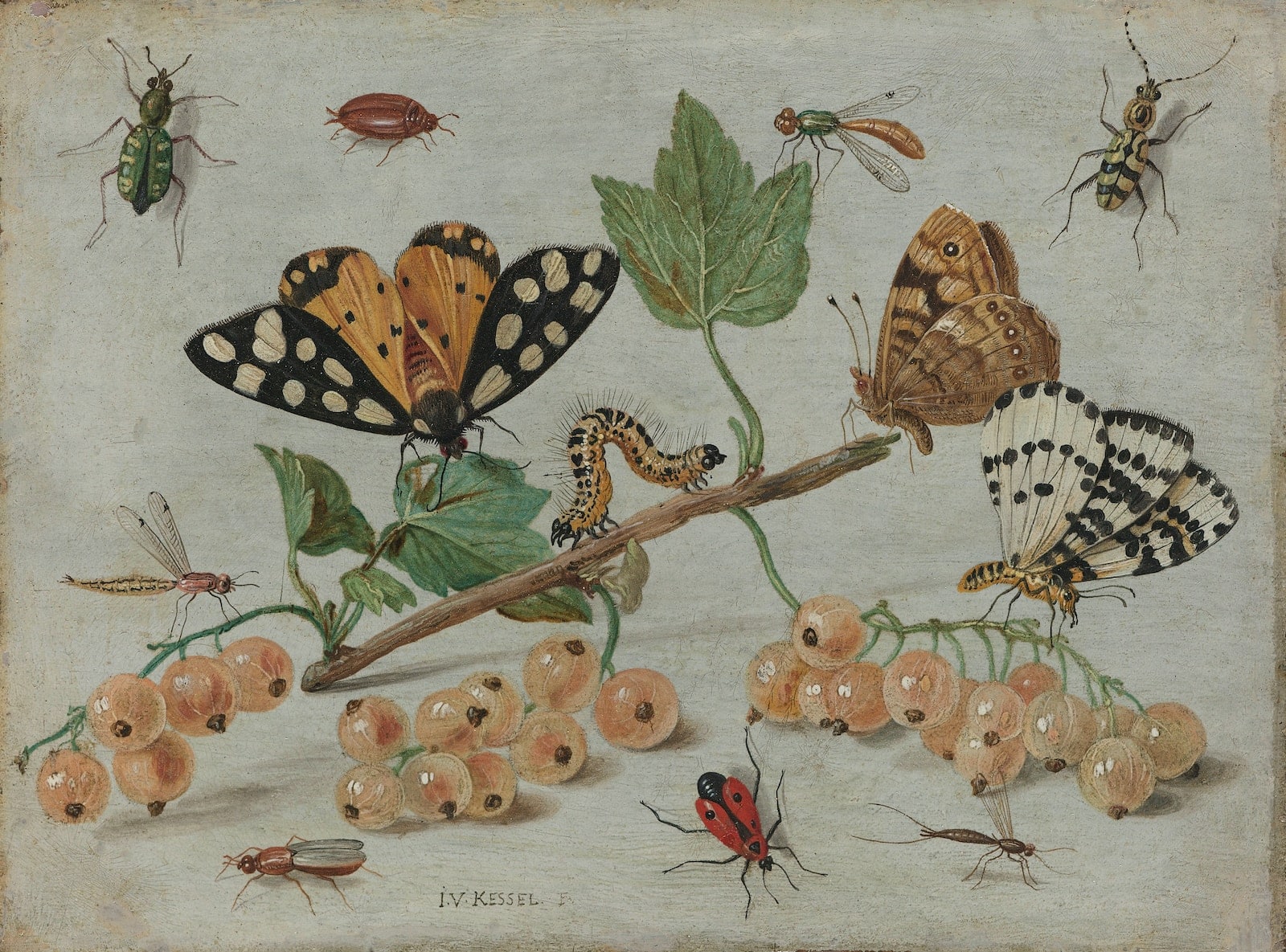Insects are the most numerous group of animals on Earth. You can find insects on every continent except Antarctica, which was the first life form to take wing in the Permian period.
The following is a list of the essential types of insects that fly worldwide. Insects are the most diverse eukaryotic organisms on Earth, with over a million described species.
You can find insects in nearly all of Earth’s environments except the sea, outer space, and the coldest parts of the poles.
Insects in General
There are many different types of insects, each with its unique anatomy. However, there are some standard features that all insects share.
For example, all insects have six legs, three body parts (head, thorax, and abdomen), and a pair of antennae.
Additionally, insects have a hard exoskeleton made up of chitin, which protects their bodies and helps them to stay hydrated.
Insects are one of the most successful groups of animals on Earth in terms of abundance and diversity. There are an estimated 10 million species of insects, making them by far the largest group of animals.
They can even live in some of the most hostile environments, such as inside volcanoes and on radioactive waste.
Due to their unique anatomy, insects can thrive in various environments. The head houses the insect’s brain, eyes, and mouthparts. And the abdomen is the location of the insect’s digestive and reproductive organs.
This simple body plan is highly versatile and allows insects to exploit many niches. Insects can also fly, which gives them another advantage over other animals.
Flight allows insects to escape predators, find new food sources, and disperse to new areas. It also enables them to exploit niches that are inaccessible to other animals.
Types of Insects That Fly
There are many different types of insects that fly. Some of the most common include bees, flies, and mosquitoes. Each insect type has its unique set of wings that allow it to pass.
Below are the types of insects that fly with their attributes.
1. Mosquitoes
As one of the types of insects that fly, mosquitoes can fly long distances and find them in many climates across the globe.
They are often considered a nuisance because of their bites, which can cause itchy red welts. Mosquitoes can also transmit diseases like malaria and the West Nile virus.
In some parts of the world, mosquitoes are responsible for many deaths yearly. Despite their reputation, mosquitoes are fascinating creatures.
They have a complicated life cycle, and their sense of smell is compassionate. Some species of mosquito can even fly in formation!
There are four main stages in the life cycle of a mosquito: the egg, larvae, pupa, and adult. The mosquito begins life as an egg laid on the water’s surface.
Once the egg hatches, the larvae emerge and feed on tiny organisms in the water. The larvae grow and molt several times before finally pupating.
And the pupa is a non-feeding stage, during which the mosquito undergoes metamorphosis into an adult.
Once the transformation is complete, the adult mosquito emerges from the pupal casing and begins to mate and lay eggs. The cycle then starts anew.
How Do Mosquitoes Fly?
Mosquitoes can fly because of their aerial navigation system. This system is mainly made for flying up their wings, which are specially adapted for flying. Their wings are tightly attached to their bodies, allowing them to move independently.
This means they can move their wings in a way that generates lift and propels them through the air.
Mosquitoes have a unique flying style in that they can fly in short bursts and then hover in the mood for long periods.
This is possible because of the shape of their wings and because of the way they flap them. They stop flapping their wings and coast through the air when they want to hover.
2. Gnat
There are a variety of different types of insects that fly, and gnats are one of them. A gnat is a tiny, winged insect related to the mosquito.
You can see gnats in nearly every habitat, including fresh and salt water, forests, grasslands, and deserts.
Although they are often considered pests, gnats play an essential role in the ecosystem as pollinators and food sources for other animals.
There are more than 1,000 species of gnats worldwide. They can be a nuisance to humans, as the moisture on our skin attracts them, and they can bite.
Gnats are also known to carry diseases, so it’s essential to avoid them if possible.
In moist organic waste or soil, the fungus gnats lay their eggs, which develop into larvae.
The larvae consume organic matter like mulch, compost, grass clippings, root hairs, fungi, and leaf mold.
They eventually develop into pupae, and from the pupae, adults are born.
Some varieties of fungus gnats, like those in the genus Bradysia, are pests of greenhouse plants’ roots and mushrooms.
Some gnats hatch from eggs that can disperse throughout water or are slightly laid on aquatic plants.
The aquatic larvae, which typically feed on plant matter, live in ponds, pools, water-filled containers, clogged rain gutters, or wet soil (living or dead). Larvae grow into pupae, which then become adults.
Adults only have enough time to reproduce and may gather in sizable mating swarms, frequently at dusk. Usually, the life cycle takes 3-5 weeks.
3. Phorid Flies
The phorid fly is one of the most common types of insects that fly. Phorid flies are small, humpbacked insects often mistaken for fruit flies.
You can see these insects in various habitats, including homes, restaurants, and other places where food is present.
They are easily attracted to decaying organic matter. You can also find them near garbage cans, drains, and other places where food waste is present.
These flies can fly long distances, and you can often see them flying in a zig-zag pattern.
Phorid flies are called “humpbacked or “scuttle” flies. Their life cycle begins when the female lays eggs on or near a food source.
The eggs hatch into larvae, which feed on the food source and then pupate. Adult flies emerge from the pupae and mate. The cycle then repeats itself.
4. Drain Flies
Drain flies are a common type of flying insect that you can find near sources of moisture, such as drains.
Dirty or stagnant water attracts them, where they get their name. These pests can’t bite or sting humans but can be a nuisance if they invade your home.
Drain flies are small, dark-colored insects with hairy bodies and wings. They can fly short distances, and you can see them near windows or doors.
If you have a drain fly problem, you may need to clean your drains and remove any organic matter attracting them.
These flies are small, dark-colored flies commonly found near drains, sewage systems, and other moist areas.
They are also known as a filter, sinks, or sewer flies. Drain flies are not known to transmit diseases, but their presence can be a nuisance.
Drain flies are often found near drains or other sources of standing water. These flies typically lay their eggs in these damp areas, and the larvae feed on the organic matter that accumulates there.
Once the larvae mature, they pupate and emerge as adult flies. The adult flies then mate and lay eggs, starting the cycle anew.
There are between 20 and 40 hours in the pupal stage. The insect doesn’t feed during this stage.
They only remain near the water’s surface and continue to breathe through a spiracle. Eventually, it becomes an adult fly, which emerges from its pupal casing through a seam.
These insects’ adults are broader and half as long as the larvae. They have hairy wings held pitched-roof style over the body.
The venation is the most simple among the Diptera, consisting merely of parallel veins without crossveins.
5. House Flies
There are many different types of insects that fly, but one of the most common is the house fly.
Warm, humid environments can attract them, and you can find them near garbage or other food sources. We consider them a nuisance because they can spread disease and contaminate food.
Once they find their way inside, they can be challenging to get rid of. House flies transmit diseases, so keeping them out of your home is essential.
You can do a few things to prevent house flies from getting inside, such as keeping your doors and windows closed and covering your food.
If you already have a house fly problem, there are various methods you can use to get rid of them, such as traps and insecticides.
The Lifecycle of House Flies
House flies undergo four life stages: egg, larva, pupa, and adult. The entire cycle, from egg to adult, can take as little as eight days under the right conditions.
A female housefly can lay up to 150 eggs at a time and will do so several times throughout her short life.
The eggs are small and white and hatch into larvae within 24 hours. Nymphs, or larvae, are legless and blind and spend their time eating and growing.
After about a week, they enter the pupal stage, undergoing metamorphosis into adulthood.
Adult house flies are about 6-7 mm long, with a gray or yellowish-gray thorax and a dark abdomen. Their thorax has two black stripes, and their wings are transparent with dark veins. Females have shorter antennae than males.
Adult houseflies can live for about two weeks when they mate, and the cycle will start anew.
6. Bees
Bees are one of the most exciting types of insects that fly. In addition to being able to fly, bees can also produce honey. This is a sweet substance that is often used in foods and drinks.
The bees make honey from the nectar of flowers. Bees are one of the types of insects that fly. They have two wings and can pass quickly and efficiently. These insects can fly because of their aerial navigation capabilities.
Their wings are specially adapted to their flying needs, allowing them to keep pace with the wind and navigate their way to their destination.
The Lifecycle of Bees
A bee’s life cycle includes the laying of an egg. Then the development of a legless larva through several molts. The legless larva turns to the pupation stage.
During this, the insect goes through complete metamorphosis and the eventual appearance of a winged adult.
A female bee’s lifetime egg production can range from eight or fewer in some solitary species to more than a million in highly social ones.
The males usually appear first and search for females to mate with. After mating, the female stores the sperm and determines which sex she wants for each egg when laying it.
Male offspring are born from unfertilized eggs, while female offspring are born from fertilized eggs.
Tropical bees may have several generations yearly but do not go through the diapause stage.
7. Cluster Flies
Cluster flies are one of the types of insects that fly. They are often found in large groups or clusters, hence their name. These insects are relatively harmless to humans and are not known to transmit any diseases.
However, they can become a nuisance if they enter your home in large numbers. Light and warmth attract cluster flies so that they may enter your home through open doors or windows.
Cluster flies are small, dark-colored flies. They are often mistaken for house flies but are not associated with filth or garbage.
Instead, they are attracted to light and warmth and often enter homes through cracks and crevices in search of a place to overwinter.
Although they are not known to carry diseases, their presence in large numbers can be a nuisance.
The Lifecycle of Cluster Flies
A cluster fly’s lifecycle begins when it lays its eggs in a suitable location, such as in a pile of manure. The eggs hatch into larvae, which then feed on decomposing organic matter.
The larvae eventually mature into adults, at which point they mate and lay their eggs. The cycle then repeats itself.
8. Fruits Flies
Fruit flies are one of the most common types of insects that people see flying around.
They are often attracted to fruit or other sweet things, where they get their name. While they may not be the most dangerous insect, they can still carry diseases.
If you come into contact with a fruit fly, it is essential to wash your hands and any affected area immediately.
Fruit flies are small, dark-colored flies often found near fruit or other sweet foods. The sugar in these foods can attract them, which can be a nuisance in homes and businesses. Fruit flies are not harmful to humans but can be a nuisance.
There are several ways to get rid of fruit flies. You can trap them with a homemade trap, purchase a commercial surprise, or use an insecticide.
However, you can also prevent them from entering your home by keeping food covered and disposing of garbage properly.
The Lifecycle of Fruits Flies
Fruit flies are one of the most common household pests. Ripened fruits and vegetables attract them, where they get their name. The female fruit fly lays her eggs on the surface of these foods.
These eggs hatch into larvae, which feed on fruit or vegetable. The larvae then pupate, and the adult fruit flies emerge. Then the adult fruit flies then mate, and the cycle begins again.
9. Filth Flies
There are many types of insects that fly, but one of the most commonly known is the filth fly.
This type of fly is often associated with dirty environments, as garbage and other sources of filth can attract them.
They can spread diseases and contaminate food, making them a nuisance to homes and businesses. Filth flies are one of the most troublesome and dirty insects.
They breed and live in filth and garbage and can spread disease to humans and animals. You can see them in hospitals, clinics, and other places where people are sick or injured.
The Lifecycle of Filth Flies
However, the lifecycle of filth flies is a fascinating and disgusting one. These flies lay their eggs in rotting organic matter, such as garbage or animal.
The eggs hatch into larvae, which then feed on the rotting matter. The larvae mature into adults, and the cycle begins anew.
10. Wasps
Wasps are one of the most common flying insects that people encounter daily. Although they are often considered pests, they play an essential role in the ecosystem.
Wasps are predators of many insects, including flies, beetles, and caterpillars. This helps to keep populations of these pests under control.
Wasps also pollinate many different types of plants. Without wasps, many plants would not be able to reproduce.
The Lifecycle of Wasps
There are three stages in the lifecycle of a wasp: the egg, the larva, and the adult. The female wasp lays eggs and hatches into a nymph.
Then the larva grows and develops into an adult. The adult wasp then mates and the cycle begins anew.
Conclusion
Insects are fascinating creatures that have been around for over 350 million years. Over this time, many different types of insects have evolved. In this article, we’ve created a list of the types of insects that fly.







